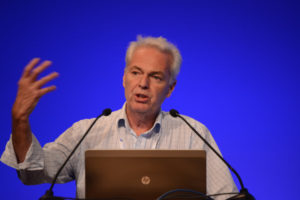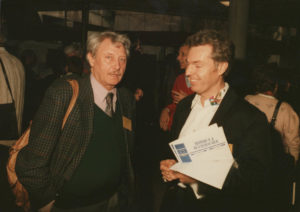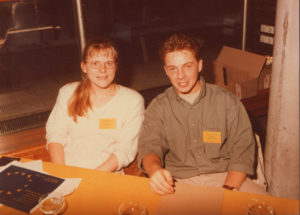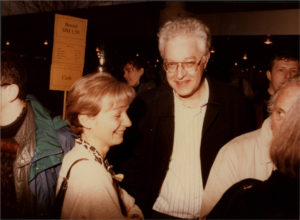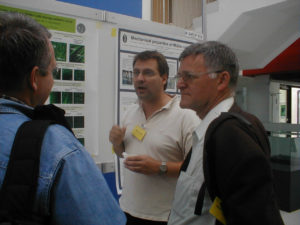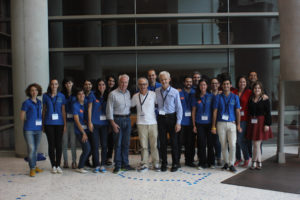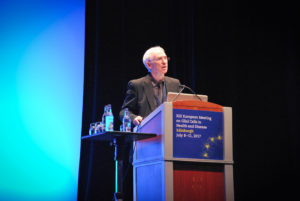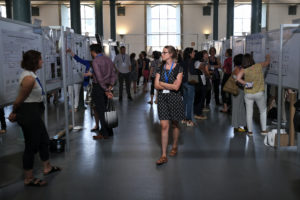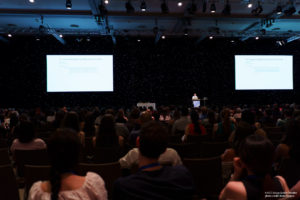The first 30 years of the European Glial Meeting
by Helmut Kettenmann
Shenzhen University of Advanced Technology, Shenzhen, China
Max-Delbrück Center for Molecular Medicine, Berlin, Germany
I am looking back at 30 years of the European Glial Meeting and the foundation of Network Glia. In the following essay, I summarize events from my personal perspective. I was involved as the local organizer of the first meeting in 1994, the 6th meeting in 2003, the 11th meeting in 2013 and the 16th meeting in 2023. I served as the first President of Network Glia from 2011 to 2023. Thus, I had much insight in the development of that meeting series and the start of Network Glia.
The start in Heidelberg in 1994
The origins of that meeting series were based on a meeting held in Heidelberg in 1994. At that time, the Deutsche Forschungsgemeinschaft (DFG, German Research Council) funded a Schwerpunkt Programm (Group Grant Initiative) between 1991 and 1997 supporting 46 projects within Germany on the topic ´Properties and Function of Glial Cells´. Details on that program, the participants and their research abstract can be found at http://networkglia.nwg-info.de/sites/networkglia.eu/files/30JahreGliaforschung/SPP/Glial%20Research%20in%20Germany_1995.pdf. I was the coordinator of the program and Meino Gibson was the administrator. The DFG typically provides funds for a mid-term meeting. I was in contact with initiatives in Europe on the topic of glial research at that time and could convince Kristian Jessen, London, and Nicole Baumann, Paris, to act as co-organizers of this meeting. Kristian Jessen had organized a meeting series together with Rhona Mirsky in London on glial cells and Nicole Baumann was President of the French glial cell club. Thus, we called the meeting “1. European Meeting on Glial Cell Function in Health and Disease”, a title which we still use today. The fact that we called that meeting ´first´ implied that we already had the vision that this would be continued. We also had a catchy short term for the meeting by dropping the N in Neuroglia – `Euroglia`. We used this and advertised the meeting as “Euroglia Meeting”. More to that later. We also used the European flag as a template for our logo and replaced the stars by glial cells. Jutta Schnitzer, at that time at the Max-Planck Institute in Frankfurt, provided the images of the cells. They were astrocytes from the cat retina originally published in 1986. Since I was based in Heidelberg at the Department of Neurobiologie (Melitta Schachner was the department head) at the time when we initiated the meeting, we had decided to organize it in Heidelberg. However, when the meeting was held, I had already accepted a position at the Max-Delbrück Center for Molecular Medicine in Berlin and was based there in the meantime. Nevertheless, I was able to get the meeting rooms at no costs at the Physics Department of the University of Heidelberg at Neuenheimer Feld. Due to that fact, due to the funds from the DFG and due to generous commercial sponsors, no registration fee for the meeting had to be charged. We were even able to offer a free snack such as the typical German “Butterbrezeln” (buttered pretzels). This initial meeting was held from March 24 – 27 and attracted 460 participants. As a special offer for the speakers, a shuttle service with my classical car from 1932 was available. Details on the meeting such as plenary speakers, posters and all abstracts you can find at http://networkglia.nwg-info.de/sites/networkglia.eu/files/30JahreGliaforschung/Glia%20Meetings%20in%20Germany/Programmhefte%20%2B%20Programme/1994%20SPP%20288%20Glia%20Meeting%20Heidelberg.pdf
The first meetings were organized by individual scientists
Two years later, the second meeting was organized by Dionysia Theodosis and Dominque Poulain in the resort place Archachon close to Bordeaux. It was smaller with about 250 participants and had a more familiar atmosphere with French wine at lunch. A meeting fee had to be introduced. Subsequently the meeting was held in Athens in 1998 organized by Rebecca Matsas, in Barcelona in 2000 organized by Bernardo Castellano, in Rome in 2002 organized by Giulio Levi. We used to meet regularly as a group of former organizers at the European glia meetings to discuss the future of that initiative but these were informal gatherings. In the meantime, the European Meeting of the Federation of the Neuroscience Societies – the FENS Forum – starting in Berlin in 1998 with me as local organizer, had become very successful. Both meetings were held at about the same time of the year and both in the even years, which meant a conflict for many European glial researchers. We therefore decided to move the glial meeting to the odd years and I had offered to hold the next meeting in Berlin in 2003. Giulio Levi had organized this gathering of the former organizers as a decision committee in a military casino and when I arrived at the place, they told me that I had to wear a tie to get access. I refused and was not allowed to enter the casino. Thus, the decision to organize the meeting in Berlin in 2003 was made in my absence.
Most of the previous meetings had been organized at university facilities which were, at the time, provided free of charge. I could organize the Berlin meeting in 2003 at the meeting facilities of the Max-Delbrück Center for Molecular Medicine where I also did not have to pay any rent. In the meantime, the meeting had grown in size and with 600 participants it reached its limits in many places as far as the space situation was concerned. Moreover, the number of posters had also increased and this required an adequate space. It became now evident that future meetings required more professional meeting sites. Thus, the next meeting in Amsterdam organized by Erik Boddeke and Christine Dijkstra was held at a commercial conference center. This created new challenges, since commercial places charge not only for space but also for equipment, staff etc. This increased the budget of such a meeting to new levels. So far, all meetings and their budget were in the personal responsibility of the local organizer. There was no financial backup by any organization. Yet, the following meetings in Amsterdam in 2005, in London in 2007 organized by Kristian Jessen and Rhona Mirsky, in Paris in 2009 organized by Anne Baron-Van Evercooren and Hervé Chneiweiss and Prague in 2011 organized by Eva Syková were still organized in the sole responsibility of the local organizers with all the financial risks involved.
One day, we received a letter asking for a royalty for the use of the term “Euroglia” in our meeting advertisement. It turned out that a nephew of Nicole Baumann had licensed the term ´Euroglia´ in Europe and received the official copyright. We had not thought about that. He threatened us to go to court, if we would not pay. We stopped completely using the term “Euroglia” and have not used it since. What a pity! At least that guy did only have costs and no revenue.
The introductory course as a novel feature
A unique feature of the meeting series are the introductory courses on glial biology. The first introductory course was held the day before the start of the Glia Meeting in Amsterdam in 2005. It then has become a tradition to organize this half-day event just a day before the actual meeting starts. It was since then repeated at each subsequent meeting, even at the virtual meeting in 2021. The aim of this one-day course is providing background information on glial biology for students and for those who are new in the field or would like to enter the field. This course is open to all glial cell researchers, also to those who do not attend the meeting, and is thus also well received by the local glia community. The speakers are experts in the field and give an introduction to the major classes of glial cells and also introduce their involvement in brain diseases. Since they either had agreed to attend the meeting or are locals there were no additional travel costs and the fee could be kept low to promote the attendance by students and even technicians. This very well attended pre-conference event attracts students, researchers from related areas, clinical scientists and industry representatives. It gathered 307 participants at the last meeting in Berlin in 2023.
Creation of Network Glia
At about that time, the Federation of the European Neuroscience Society (FENS) had decided to organize their meeting in a more professional way. They planned to involve a professional congress organizer (PCO) and made a call for bids. This development was during my time as President of FENS (2008-2010) and Past-President (2010-2012) and I had organized this selection meeting for a PCO at the MDC in May 2009. It was clear to me, that the glial meeting needed something equivalent. FENS was a legal organization registered in Brussels and could therefore serve as a legal partner to make a contract with the PCO. As a consequence, we had to create a legal organization for the Glia Meetings as well. This resulted in the birth of Network Glia in 2011.
I took the initiative and served as president. I could convince Kristian Jessen to serve as secretary general and Erik Boddeke to serve as treasurer. Formal members of that organization were all previous organizers of Glia Meetings. We registered Network Glia as a non-profit organization in Berlin (formally a ´eingetragener Verein, e. V.´). Together with Meino Gibson, I defined the statutes which had to be in German language as requested by the German law. This enabled us to negotiate a contract with a PCO and we chose a company in Berlin, K.I.T.. I had known the company from the FENS bid and the CEO Willy Kausch from interactions at the MDC. We received an attractive offer. K.I.T. Group GmbH Dresden would cover all costs in the event that the meeting makes losses and we would share the profit 50/50 if there is a positive result. With this arrangement a great burden was lifted from the shoulders of the local organizer. Meino Gibson served as the local administrator of the charity and organized all matters. The office was located at the MDC in Berlin. The first meeting under this new arrangement was the Berlin meeting in 2013 at a very attractive commercial congress center, the Estrel complex. K.I.T. Group GmbH Dresden was not only very instrumental in negotiating a good deal for the meeting site, in addition we could also offer the participants attractive room rates at the hotel of the Congress center. As a result, the meeting was a financial success as were the following meetings.
Meetings under the wing of Network Glia
The following meetings were also organized by K.I.T. Group GmbH Dresden. Stephane Talboom at K.I.T. was instrumental in the first years to negotiate the conditions at the meeting site together with the local organizer and the executive committee of Network Glia. Meino Gibson was running the Network Glia office at the MDC and was dealing with all administrative issues including those related to maintain the charity status of this organization. The subsequent meetings were 2015 in Bilbao, organized by Carlos Matute, in Edinburgh in 2017 organized by Charles ffrench-Constant and Peter Brophy, and in Porto in 2019 by João Bettencourt Relvas and Monica Sousa. For 2021, the meeting was planned to be held in Marseille, but then the corona virus stopped all travelling activities and the meeting was organized as a virtual meeting. It was possible to save the reservation money for a meeting 4 years later, since for 2023 Berlin was already arranged and the facility booked.
Site visits for the selection of the meeting site.
After signing the contract with the PCO, the site selection was now subject to new criteria. While in the past the commitment of the local glia community was a major criterion, now the costs and size of the conference center were also influencing the selection, and the board of Network Glia was advised in these matters by the PCO. Thus, common site visits with members of the Nework Glia board and the people from K.I.T. Group GmbH Dresden were organized for the first time in 2013 for the meeting in 2015. K.I.T. Group GmbH Dresden had made a SWOT analysis for suitable venues and Madrid seemed to be the most attractive. However, during the site visit it turned out that the venue was located in a remote area and was inappropriate concerning facilities. In addition, due to the very hot and dry climate in July, Madrid was not optimal during that period. Finally, after several internal discussions, Bilbao was chosen as an alternative. At a second site visit, we found that it had a very nice congress center with a pleasant Atlantic climate. After this experience, site visits had been introduced as a usual procedure for site selection.
We had internal discussion of moving the meeting outside of Europe. Over the past years there was an increasing number of participants outside Europe, in particular from the US. Yet there was a strong opinion among the board of Network Glia to leave the meeting in Europe.
Creation of an independent program committee
We were now formally visible as an executive committee and a small group of members of Network Glia. So far, the selection of symposia and speakers and the composition of the programme was in the responsibility of the local organizer. This meant too much control by too few scientists. We had to open ourselves to the global community. Therefore, we planned to establish an independent programme committee. As a first step, we asked all speakers of the Berlin meeting in 2013 whether they would like to candidate for the programme committee. We had previously introduced the rule that a speaker of a given meeting could not speak at the next meeting, so being a candidate was no handicap for being a speaker at the next meeting. We defined the topic categories ´astrocytes, oligodendrocytes, microglia, Schwann cells and stem cells´ and the candidates had to select for which topic they would like to run. We asked all participants of the Berlin meeting to vote online and this was organized by the Berlin office. It was a great success – 415 participants out of 1.108 voted. The elected members were then asked to vote for a chairman of the committee. Anne Baron-Van Evercooren was elected and she could nominate three additional members to compensate for an uneven distribution with respect to gender or regions/countries. The local organizer was also included as member and later the chair of the committee of the previous meeting. From now on, it was the task of this committee to select the symposia and key note speakers for the meeting. This procedure has been repeated after every subsequent meeting and has become a unique feature of that meeting. In the meantime, it has become a tradition for the participants to get involved in shaping the future meetings.
Developing the homepage of Network Glia as a hub
We developed a website for Network Glia to make this association visible to the glia community worldwide (https://www.networkglia.eu/). In addition to some technical information on the Glia meetings we started adding useful information beyond that related to the meeting. We e.g. created a download center for historical articles such as the original articles from Virchow, Müller (Müller cells), Bergmann (Bergmann glial cells) or Hortega. We summarized all activities and meetings related to glial cells in Germany over the last 30 years and hope to get similar accounts from other countries. Furthermore, there is information on animal models and genomic screens (astrocyte enriched genes and entire transcriptome). The challenge is to always keeping these sites updated.
The meeting grows beyond Europe
As mentioned above, the glia meeting started with 460 participants in 1994 in Berlin. It constantly grew over the years to a maximum participation in Porto with over 1.500 participants. In 2021 with the virtual meeting during Corona, there were still over 1.000 participants. The meeting in Berlin in 2023 showed an upturn again, but has not yet fully recovered with around 1.490 particpants.
Traditionally, the European participation is the strongest in the meetings with Germany, France, UK, Switzerland and Italy always among the top five countries. However, in 2023 for the first time a non-European country was most strongly represented, namely the US, accounting for 17 percent of participants. While until 2021 around 25 percent of the participants came from outside Europe, in 2023 32 percent came from outside with an increasing participation from US and Asia. This shows that this meeting is developing into the direction of a world meeting for the glial community.
Outlook for the future
In 2023, I served once more – and for the forth time – as a local organizer of the Glia meeting in Berlin. With the end of the meeting, I announced that I would like to pass on my responsibility for Network Glia at the end of 2023. I had taken on new challenges in China and had organized the first Microglial Meeting in March 2023 in Shenzhen and the second one will happen in November 2024. I thus ended my term as President of Network Glia at the end of 2023.
The new executive committee is now in the hands of Leda Dimou as President, Carlos Matute as Secretary General and João Bettencourt Relvas as Treasurer. I wish them all success.

